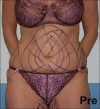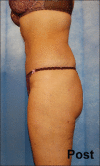Avoiding unfavourable outcomes in liposuction
- PMID: 24501475
- PMCID: PMC3901920
- DOI: 10.4103/0970-0358.118618
Avoiding unfavourable outcomes in liposuction
Abstract
The origin of liposuction can be traced to an adverse event by Dujarrier in 1921 when he used a uterine curette to remove fat from the knees of a ballerina ending in an amputation secondary to damage of the femoral artery. The history of liposuction since then has been one of avoiding complications and optimising outcome. After this adverse event, liposuction was abandoned until the 1960's when Schrudde revived the practice using small stab incisions and sharp curettage with the secondary suction to aspirate the freed tissue. This technique was associated with a high incidence of complications especially seroma and skin necrosis. Illouz then replaced the curette with a blunt cannula connected to vacuum pump thus avoiding the complications of a sharp curette. Despite the presence of various techniques for liposuction, suction assisted liposuction (SAL) is still the standard technique of liposuction. This article aims to discuss literature regarding the various aspects of liposuction (SAL) and to highlight the salient points in the literature and in the senior author's experience in order to avoid unfavourable outcomes in liposuction. A literature review on avoiding complication is in liposuction including some of the seminal papers on liposuction. Liposuction is generally a safe procedure with reproducible outcome. Just like any surgical procedure it should be treated with the utmost care. Illouz published 10 commandments for liposuction in 1989 and we review these commandments to demonstrate how liposuction has evolved.
Keywords: Complications; liposuction; suction assisted liposuction.
Conflict of interest statement
Figures
Similar articles
-
1,000 consecutive cases of laser-assisted liposuction and suction-assisted lipectomy managed with local anesthesia.Aesthetic Plast Surg. 2012 Aug;36(4):795-802. doi: 10.1007/s00266-012-9885-2. Epub 2012 Mar 24. Aesthetic Plast Surg. 2012. PMID: 22447150
-
Liposuction devices: technology update.Med Devices (Auckl). 2014 Jul 21;7:241-51. doi: 10.2147/MDER.S47322. eCollection 2014. Med Devices (Auckl). 2014. PMID: 25093000 Free PMC article. Review.
-
Evidence-Based Practice in Liposuction.Ann Plast Surg. 2018 Jun;80(6S Suppl 6):S403-S405. doi: 10.1097/SAP.0000000000001325. Ann Plast Surg. 2018. PMID: 29369106 Review.
-
The tissue effects of ultrasound-assisted lipoplasty.Plast Reconstr Surg. 1998 Jul;102(1):213-20. doi: 10.1097/00006534-199807000-00035. Plast Reconstr Surg. 1998. PMID: 9655430
-
Surgical treatment of axillary hyperhidrosis: a study comparing liposuction cannulas with a suction-curettage cannula.Ann Plast Surg. 2006 Jun;56(6):654-7. doi: 10.1097/01.sap.0000205771.40918.b3. Ann Plast Surg. 2006. PMID: 16721080
Cited by
-
Impact of Body Mass Index on Outcomes of Patients Undergoing Liposculpture in Private Practice.Plast Reconstr Surg Glob Open. 2024 Nov 20;12(11):e6291. doi: 10.1097/GOX.0000000000006291. eCollection 2024 Nov. Plast Reconstr Surg Glob Open. 2024. PMID: 39568686 Free PMC article.
-
Aesthetic Surgery Gone Wrong: A Case Report and Literature Review of Acute Kidney Injury Secondary to Hematoma After Liposuction.Cureus. 2023 Jun 1;15(6):e39820. doi: 10.7759/cureus.39820. eCollection 2023 Jun. Cureus. 2023. PMID: 37397664 Free PMC article.
-
A novel method to insert drain atraumatically after liposuction in gynaecomastia.Indian J Plast Surg. 2018 Jan-Apr;51(1):102-103. doi: 10.4103/ijps.IJPS_1_18. Indian J Plast Surg. 2018. PMID: 29928090 Free PMC article. No abstract available.
References
-
- Scuderi N, Paolini G, Grippaudo FR, Tenna S. Comparative evaluation of traditional, ultrasonic, and pneumatic assisted lipoplasty: Analysis of local and systemic effects, efficacy, and costs of these methods. Aesthetic Plast Surg. 2000;24:395–400. - PubMed
-
- Grazer FM. Suction-assisted lipectomy, suction lipectomy, lipolysis, and lipexeresis. Plast Reconstr Surg. 1983;72:620–3. - PubMed
-
- Regnault P, Daniel RK. Abdominoplasty. In: Regnault P, Daniel RK, editors. Aesthetic Plastic Surgery. Boston: Little Brown; 1984. Ch. 25.
-
- Illouz YG. Body contouring by lipolysis: A 5-year experience with over 3000 cases. Plast Reconstr Surg. 1983;72:591–7. - PubMed
-
- Hetter GP. Optimum vacuum pressures for lipolysis. Aesthetic Plast Surg. 1984;8:23–6. - PubMed
Publication types
LinkOut - more resources
Full Text Sources
Other Literature Sources








